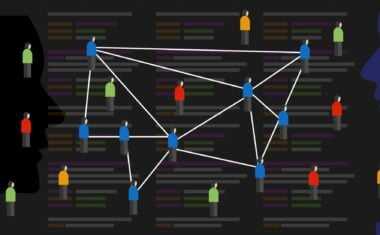Keras vs TensorFlow: What’s The Difference?
In this article
Should you be using Keras or TensorFlow? This Keras vs TensorFlow article will answer all of your questions. The first step towards building a powerful deep learning model is choosing the right framework. A deep learning framework is a library, interface, or tool that allows you to build machine learning models quickly and easily with the help of pre-built and reusable components. While TensorFlow is the most popular library, Keras is also slowly gaining popularity because of its user-friendliness. But, to pick one, you need to understand the difference between the two.
Keras vs TensorFlow: Understanding the difference
Let’s discuss both TensorFlow and Keras separately before we dig deep into their differentiating features.
What is TensorFlow?
An open-source machine learning framework, TensorFlow was created by Google to make it easier for developers to design machine learning models. It is a flexible and comprehensive ecosystem of libraries, tools, and other resources that offers workflows with high-level and low-level APIs.
Since TensorFlow is cross-platform, it can be used to create models for different platforms like CPUs, GPUs, browsers and even IoT devices. It leverages the power of Python to offer an easily accessible front-end API. Though, it is important to note that all the computations are carried out in C++.
Some of the many incredible features are:
- There are multiple levels of abstraction which make it easy to build and train machine learning models
- With TensorFlow, you can deploy models easily, regardless of the platform or language that you use
- Tensorflow can help developers in visualizing neural networks through graphical computation
What is Keras?
Keras is a high-level neural network library that runs on top of TensorFlow. By working as a wrapper for low-level libraries like TensorFlow, Keras makes it easy for developers to quickly code and create deep learning models. The entire framework is in Python which leads to easy debugging and accessibility. Compared to TensorFlow, Keras is more user-friendly and easier to use. So, if you are new to deep learning and want to create a new model from scratch, then it would be a better option to start with Keras. Since it runs on top of TensorFlow, the same CPU and GPU compatibility apply here as well. Though, in most cases, Keras is used to build deep learning models while TensorFlow is used to create broad machine learning models.
Some of the many benefits of Keras include:
- It has a user-friendly and simple interface that is optimized for all the common use cases. It can also give accurate feedback for any user errors
- The models in Keras are made by connecting together configurable building blocks
- Consistent and simplified APIs make the entire development process quick
Related Read: What is Data Science?
Get To Know Other Data Science Students
Jasmine Kyung
Senior Operations Engineer at Raytheon Technologies
Karen Masterson
Data Analyst at Verizon Digital Media Services
Haotian Wu
Data Scientist at RepTrak
Keras vs TensorFlow: What’s The Difference?
1. Flexibility
When it comes to flexibility, Tensorflow can be tweaked and modified much more than Keras, mainly because the former supports low-level libraries which themselves provide a lot of flexibility to the developers.
2. Functionality
While Keras does offer all the generic functionalities to create and build deep learning models and it is only good for beginners. If you are looking for advanced features and operations, then TensorFlow is the best way to go.
It is also preferable to use TensorFlow if you are developing a custom or special kind of deep learning model.
3. Threading and queues
With queues, it becomes possible to accurately compute tensors in the graph asynchronously. It is also easier to execute multiple threads in the same session through parallel computations which in turn speeds up the entire process. If your model requires the use of queues or threads, then it’s best to go with TensorFlow.
4. Debugger
Another place where TensorFlow gets ahead of Keras is the debugger. With TensorFlow, you get access to a specialized debugger which gives you more visibility into the internal structure as well as the running state of the different TensorFlow graphs. You can then use the insights from the debugger to identify and rectify issues.
5. Keras vs TensorFlow: Control
Since TensorFlow offers more flexibility and advanced options, you also get more control over your network. Whether you want to perform operations on weights, gradients or anything else, it can be done easily with TensorFlow.
While it is important to weigh your options and compare Keras vs Tensorflow, you should also remember that it is possible to use them both and get the best of both worlds because Keras works as a wrapper for Tensorflow framework.
Related Read: Data Scientist Job Description
Since you’re here…Are you a future data scientist? Investigate with our free guide to what a data scientist actually does. When you’re ready to build a CV that will make hiring managers melt, join our Data Science Bootcamp that guarantees a job or your tuition back!





